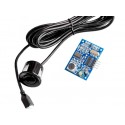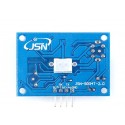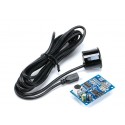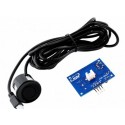-This ultrasonic sensor is very similar to the ultrasonic sensors which are found in cars.
-This Waterproof Ultrasonic Obstacle Sensor shows some important constructional advantages over the conventional sensors.
-It comes in two separate parts one being the transducer which is the sensing element and the other being the control board.
-The module is capable of providing information of the objects between the distance range of 250 mm to 4500 mm.
-The great advantage of using this Waterproof Ultrasonic Obstacle Sensor is you can put the sensing element far away from all the control circuitry.
-This Ultrasonic Distance Sensor is an industrial-grade sensor to measure distance.
-Interfacing with it is the same as another cheap ultrasonic sensor, but it offers better performance and is compatible with harsher environments and is waterproof too! It can be easily interfaced with Arduino and Sample codes and projects are available.
-There are many ultrasonic distance sensors on the market, but sometimes, this kind of sensor needs to work in vulnerable conditions.
-This Waterproof Ultrasonic Obstacle Sensor meets this requirement.
-It has a good performance and almost the same usage of an HC-SR04 module.
-It is very easy to use, a control port with a 10US above high level can wait for high-level output at the receiving port.
-An output can drive the timer when this port is low can read the timer value, this time for the location of the time can be distance measurement.
-Constantly cycle tests that can achieve the measurement of the value of your mobile.
The basic working principle:
Turn on TRIG Pin to 5V for at least 10uS
The module will then automatically send 8 40KHz tones and automatically detect when the signal return after reflecting back from the object
Upon detecting the signal, a high-level signal is outputted through the IO Pin ECHO. By keeping track of the time duration between transmitting and receiving the signal, the distance can be calculated. Distance = (Time to Receive Reflected Signal * speed of sound (340M/S)) /2
Wiring
+5V(positive)
Trig(control)
Echo(receive)
GND(negative)
Application:
-Horizontal distance
-Obstacle avoidance, automatic control
-Traffic control
-Security, industrial control
-Artificial intelligence, and research.
Features:
-Small size, easy to use.
-Low voltage, low power consumption.
-High accuracy.
-Strong anti-jamming.
-Integrated with wire enclosed waterproof probe, suitable for wet, harsh measurement occasions.
| SPECIFICATIONS: |
|
| Operating voltage (v) |
5 |
| Operating Current (mA) |
30 |
| Static Current (mA) |
5 |
| Operating Range |
25cm ~ 4.5m |
| Resolution |
0.5 cm |
| Detecting Angle |
< 70° |
| Operating Temperature (℃) |
-10 ~ +70 |
| Cable Length |
2.5 meter |
| Shipment Weight |
0.125 kg |
| Shipment Dimensions |
13 × 9 × 5 cm |
OVERVIEW:
-Integrated with wire enclosed waterproof probe, suitable for wet, harsh measurement occasions
-Small size, easy to use
-Operating Voltage: 5 V
-Sonar Sensing Range: 25-450 cm
-Max. Sensing Range: 450 cm
-Frequency: 40 KHz
-₹ 835.00 (inc GST)
-₹ 707.63 (+18% GST extra)
PACKAGE INCLUDES:
1 PCS x Jsn Sr04T Waterproof Ultrasonic Sensor Reversing Radar Sensor
//SOURCE CODE TAKEN FROM BEOW LINK
//https://create.arduino.cc/projecthub/SurtrTech/measure-distance-using-jsn-sr-04t-lcd-42af60
/* This code works with JSN SR04 T ultrasound module
* It measures the distance and shows it on the Serial monitor
* Refer to www.SurtrTech. com or SurtrTech YT channel for more informations
*/
#define TRIG 11 //Module pins
#define ECHO 12
void setup() {
Serial.begin(9600); // Serial monitoring
pinMode(TRIG, OUTPUT); // Initializing Trigger Output and Echo Input
pinMode(ECHO, INPUT_PULLUP);
}
void loop() {
digitalWrite(TRIG, LOW); // Set the trigger pin to low for 2uS
delayMicroseconds(2);
digitalWrite(TRIG, HIGH); // Send a 10uS high to trigger ranging
delayMicroseconds(20);
digitalWrite(TRIG, LOW); // Send pin low again
int distance = pulseIn(ECHO, HIGH,26000); // Read in times pulse
distance= distance/58; //Convert the pulse duration to distance
//You can add other math functions to calibrate it well
Serial.print("Distance ");
Serial.print(distance);
Serial.println("cm");
delay(50);
}
 9962060070
9962060070





